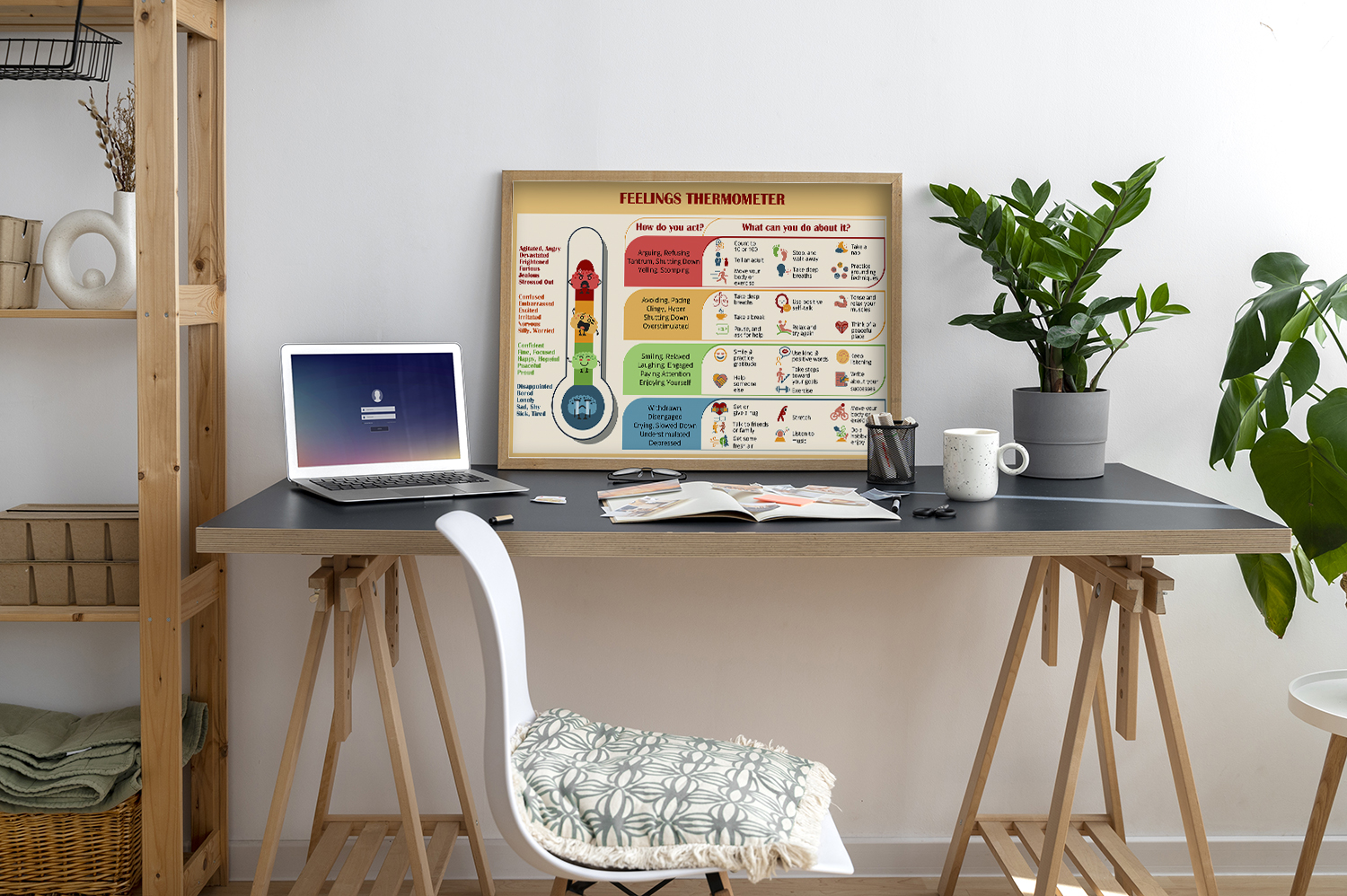The Feelings Thermometer empowers you to master your emotions
Emotions are a natural part of being human, but sometimes emotional storms hit us that are difficult to control. Have you ever felt lost amidst a whirlwind of emotions? Don’t worry, LOLUIS brings you the “Feelings Thermometer” – your companion in understanding and navigating your emotions effectively.
What is the Feelings Thermometer?
The “Feelings Thermometer” is a vivid visual tool that helps you identify and categorize your emotions from positive to negative. Designed like a real thermometer, each level corresponds to a group of emotions and how you might express them.
How to Use the Feelings Thermometer:

Step 1: Identify Your Emotions
Carefully observe the “measurement column” on the left side of the poster, which shows the levels of emotions from highest (top) to lowest (bottom). Each level is illustrated with facial expressions and different colors for easy identification.
Focus on the dominant emotion you are experiencing. For example:
- If you are feeling irritated or angry, you may be at the “Agitated, Angry” level.
- If you are worried or scared, consider the “Scared, Anxious, Frightened” level.
- If you are feeling happy and excited, you are likely at the “Happy, Hopeful, Peaceful” level.
- Don’t hesitate to refer to the detailed descriptions of each emotion listed below each level for the most accurate identification of your feelings.

Step 2: Understand Your Expressions
Once you have identified your emotional state on the “Thermometer,” look at the corresponding “action column” of the same color next to it.
This column describes the ways you typically express yourself when experiencing that group of emotions. For instance:
- When “Agitated, Angry,” you may tend to be “Arguing, Refusing, Tantrum, Shutting Down.”
- When “Scared, Anxious, Frightened,” you are more likely to be “Avoiding, Pacing, Clingy, Hyper.”
- Recognizing how you express your emotions will help you become more aware of your behavior and, in turn, control them more effectively.
Step 3: Choose A Solution From The Feelings Thermometer
After understanding your emotions and how they manifest, the “solution column” of the LOLUIS “Feelings Thermometer” will be the “golden key” to help you navigate your emotions effectively. The solution column, sharing the same color as the emotion and action columns, offers practical and easy-to-apply suggestions for each specific emotion group.

When Your Emotions Run High:
This is when you’re experiencing Agitated, Angry, Devastated, Frightened, Furious, Jealous, or Stressed Out. You might find yourself Arguing, Refusing, having a Tantrum, Yelling, or Shutting Down.
Here’s what you can do:
- Count to 10 or 100: Breathe deeply and count slowly. This helps regain immediate composure.
- Stop, and walk away: Take a break from the situation.
- Move your body or exercise: Physical activity can help release tension.
- Tell an adult: Talking to a trusted adult can provide support and guidance.
- Take deep breaths: Focus on your breathing to calm your nervous system.
- Take a break: Allow yourself time and space to process your emotions.
- Pause, and ask for help: It’s okay to reach out for support when needed.
When You Feel Scared, Anxious, or Frightened:
These emotions might manifest as Avoiding, Pacing, being Clingy, Hyper, Shutting Down, or feeling Overstimulated.
Try these strategies:
- Take deep breaths: Regain control of your breathing to ease anxiety.
- Take a break: Step away from the situation causing distress.
- Pause, and ask for help: Reach out to someone you trust for support.
- Use positive self-talk: Counteract negative thoughts with encouraging words.
- Relax and try again: Once calmer, approach the situation with renewed composure.
- Think of a peaceful place: Visualize a calming environment to soothe your mind.
When You’re Overflowing with Positive Emotions:
This is when you’re feeling Confident, Fine, Focused, Happy, Hopeful, Peaceful, or Proud. You’re Smiling, Relaxed, Laughing, Engaged, Paying Attention, and Enjoying Yourself.
Amplify those good vibes:
- Smile & practice gratitude: Embrace positivity and appreciate the good in your life.
- Use kind & positive words: Spread joy and encouragement through your words.
- Take steps toward your goals: Channel positive energy into pursuing your aspirations.
- Help someone else: Share your good fortune and experience the joy of giving.
- Exercise: Celebrate your well-being with physical activity.
When Your Mood Takes a Dip:
You might feel Disappointed, Bored, Lonely, Sad, Shy, Sick, Tired, Withdrawn, or Depressed. These emotions may leave you feeling Disengaged, Crying, Slowed Down, Understimulated, or Depressed.
Here are some ways to uplift your spirits:
- Stretch: Gentle stretches can help relieve tension and improve mood.
- Listen to music: Let your favorite tunes uplift your spirit.
- Exercise: Boost your mood and energy levels with physical activity.
- Move your body or exercise: Counteract lethargy with movement and exercise.
- Get a hug: Experience the comfort and support of a warm embrace.
- Talk to friends or family: Share your feelings and seek understanding and connection.
- Get some fresh air: Nature’s restorative power can do wonders for your mood.
- Do a hobby you enjoy: Engage in activities that bring you joy and a sense of accomplishment.
Remember, managing emotions is a long journey and requires patience. The “Feelings Thermometer” will be a reliable companion, helping you understand yourself and build a healthy and happy mental life!
Follow me at LOLUIS – Mental Health Decor for more information.


